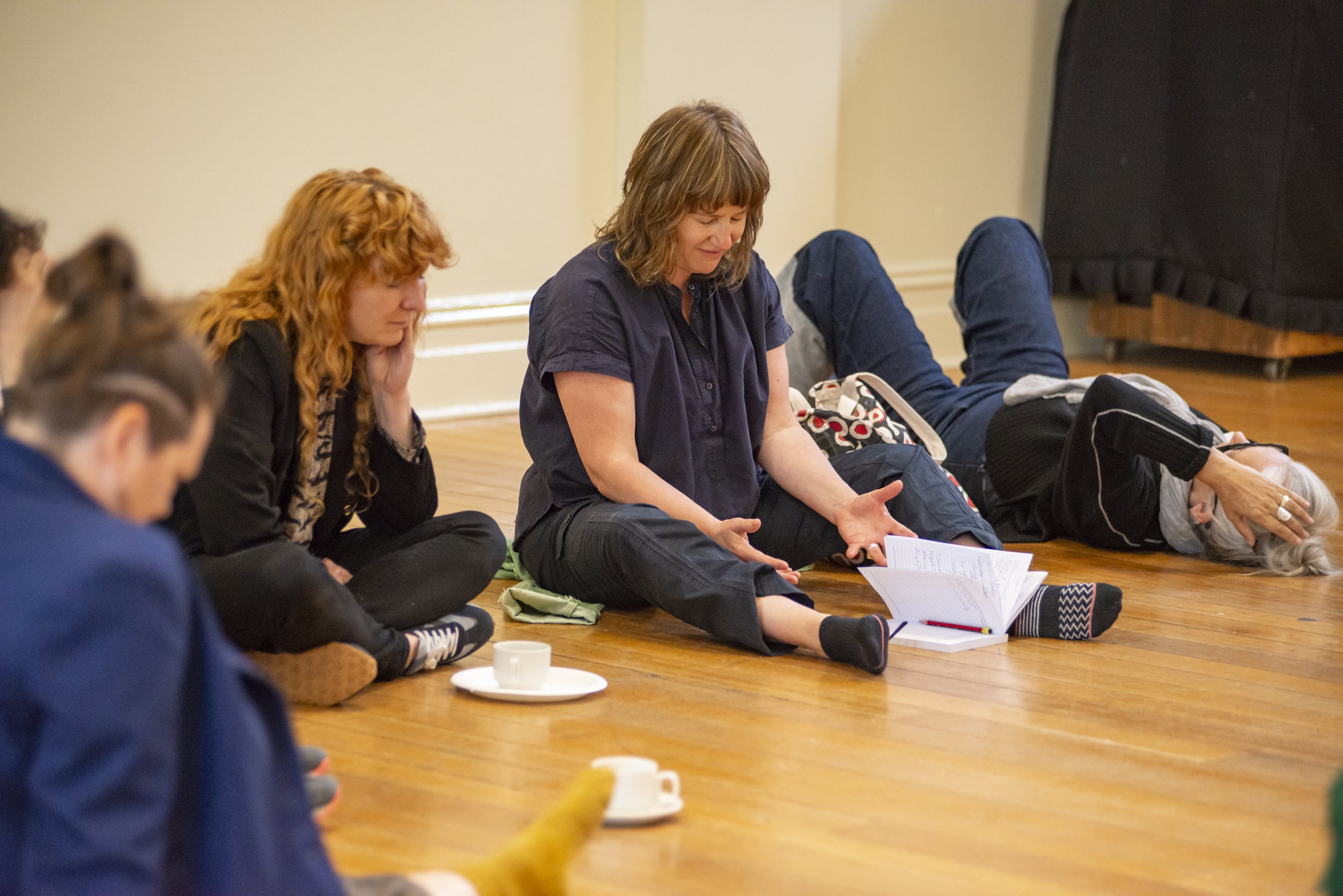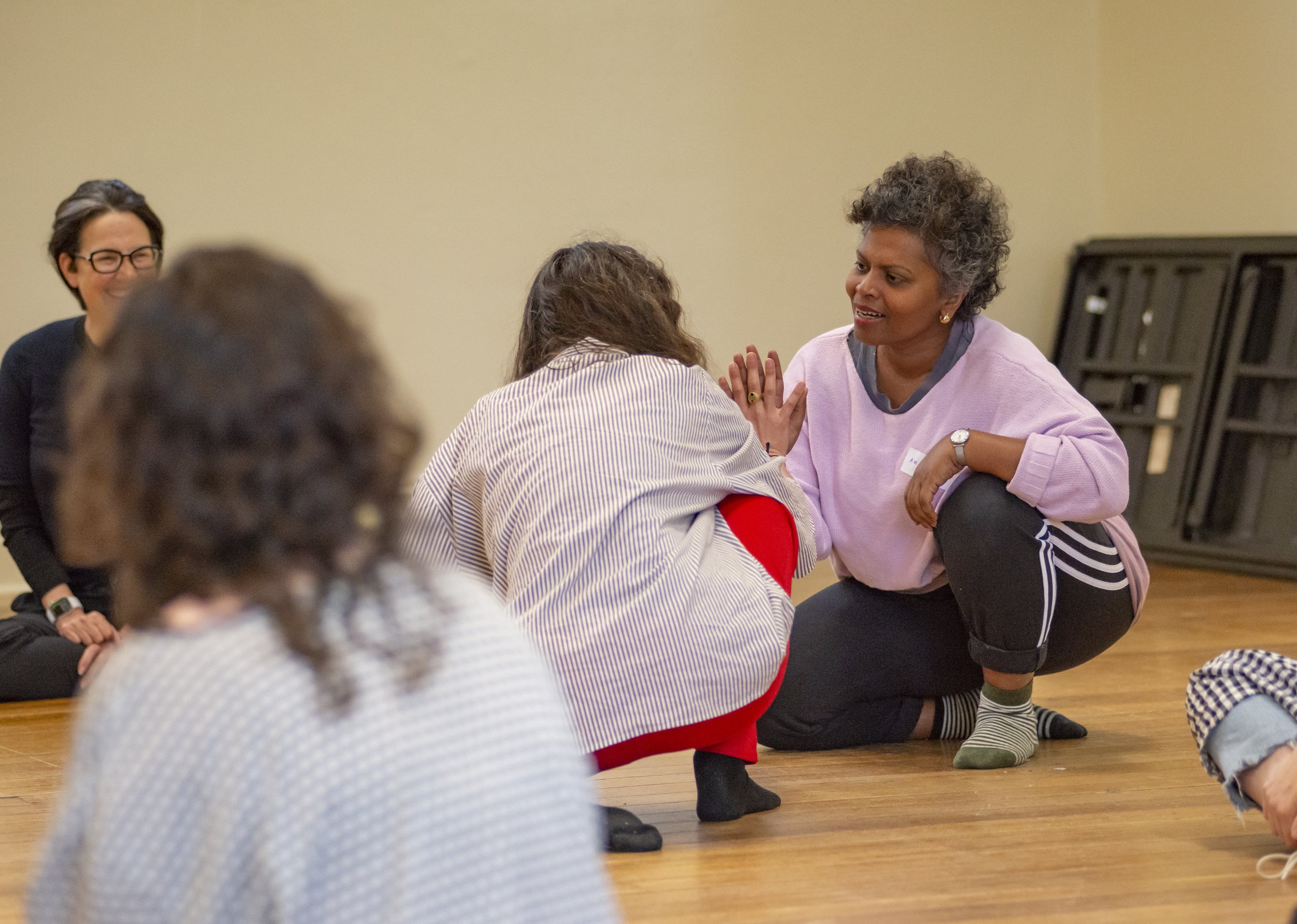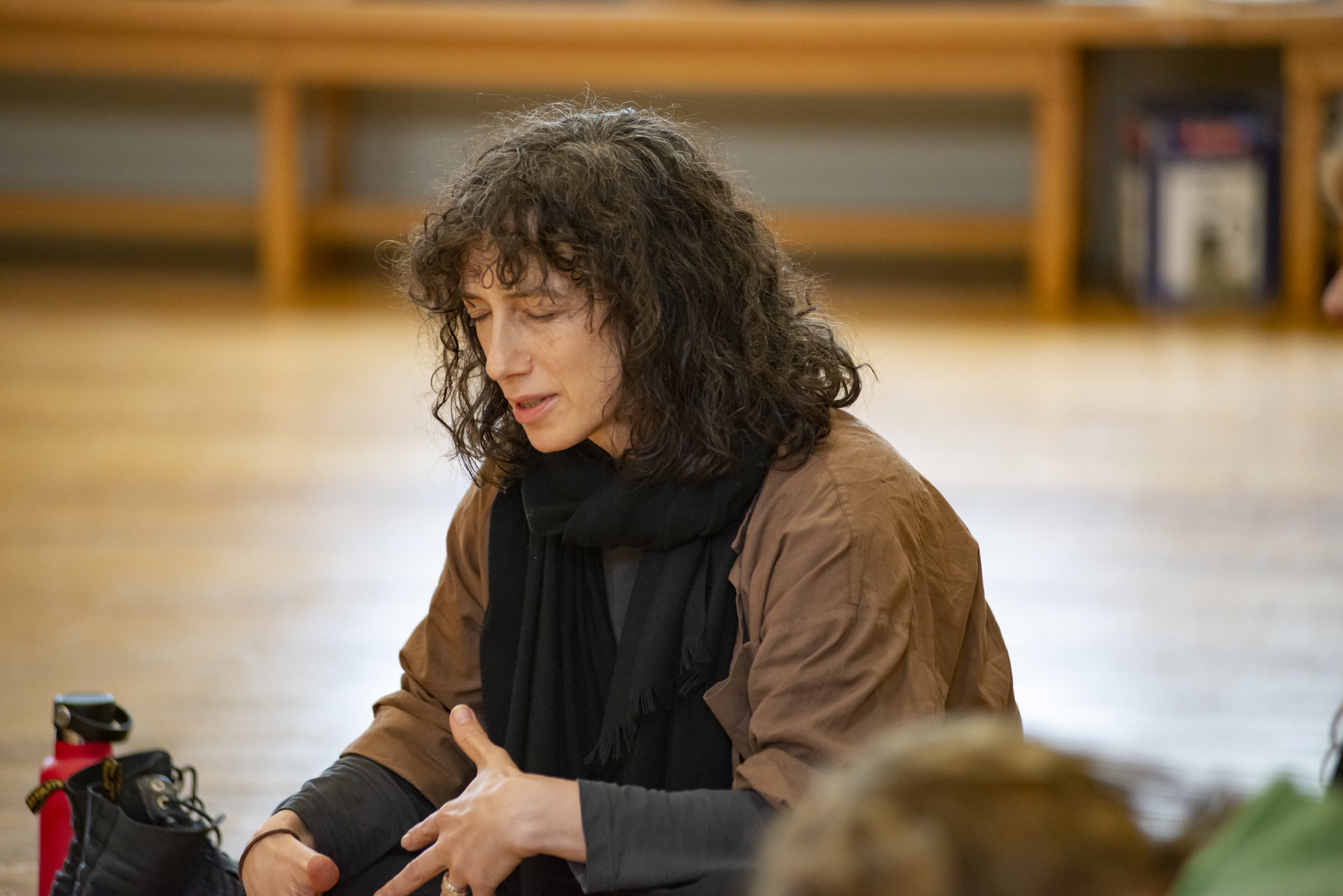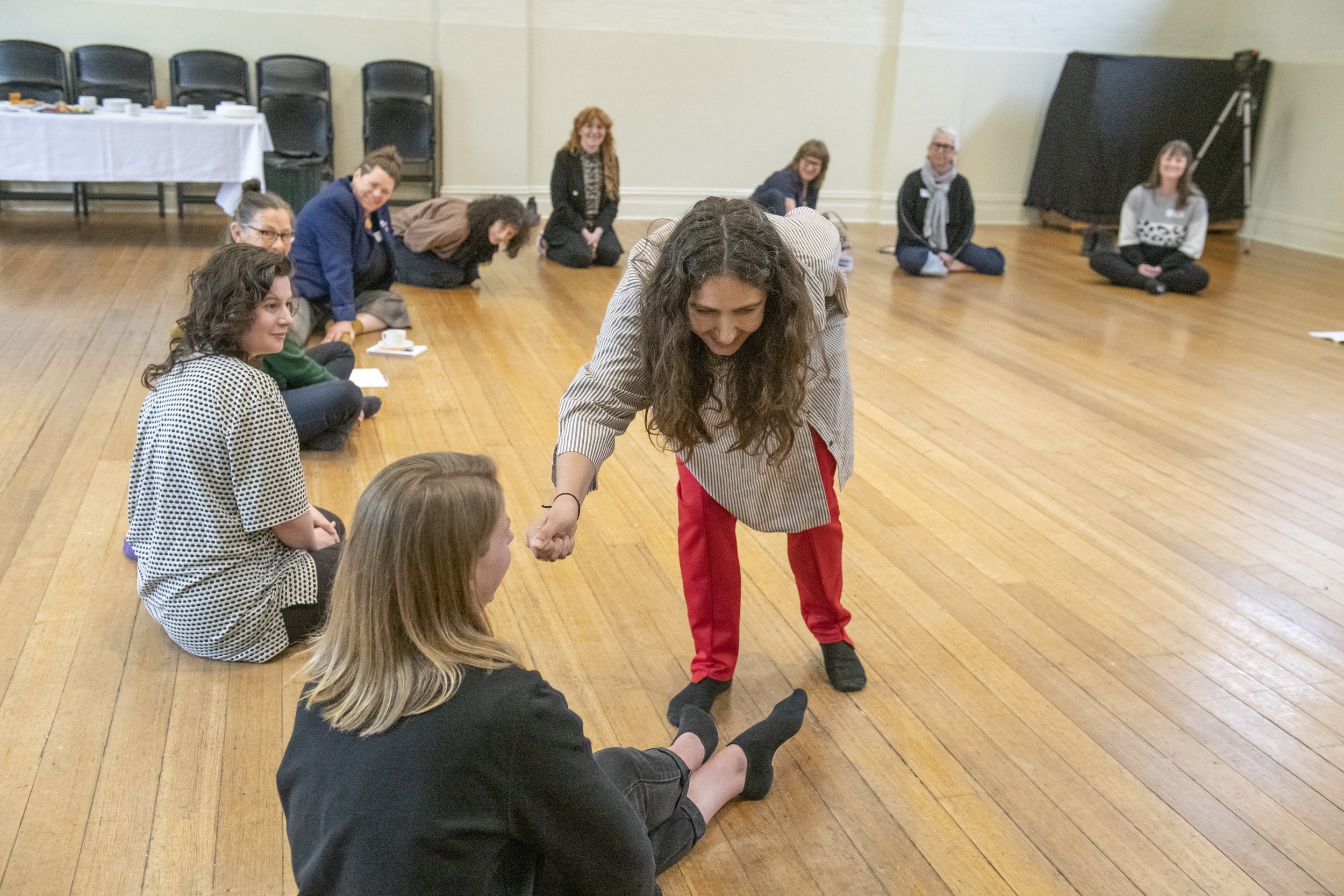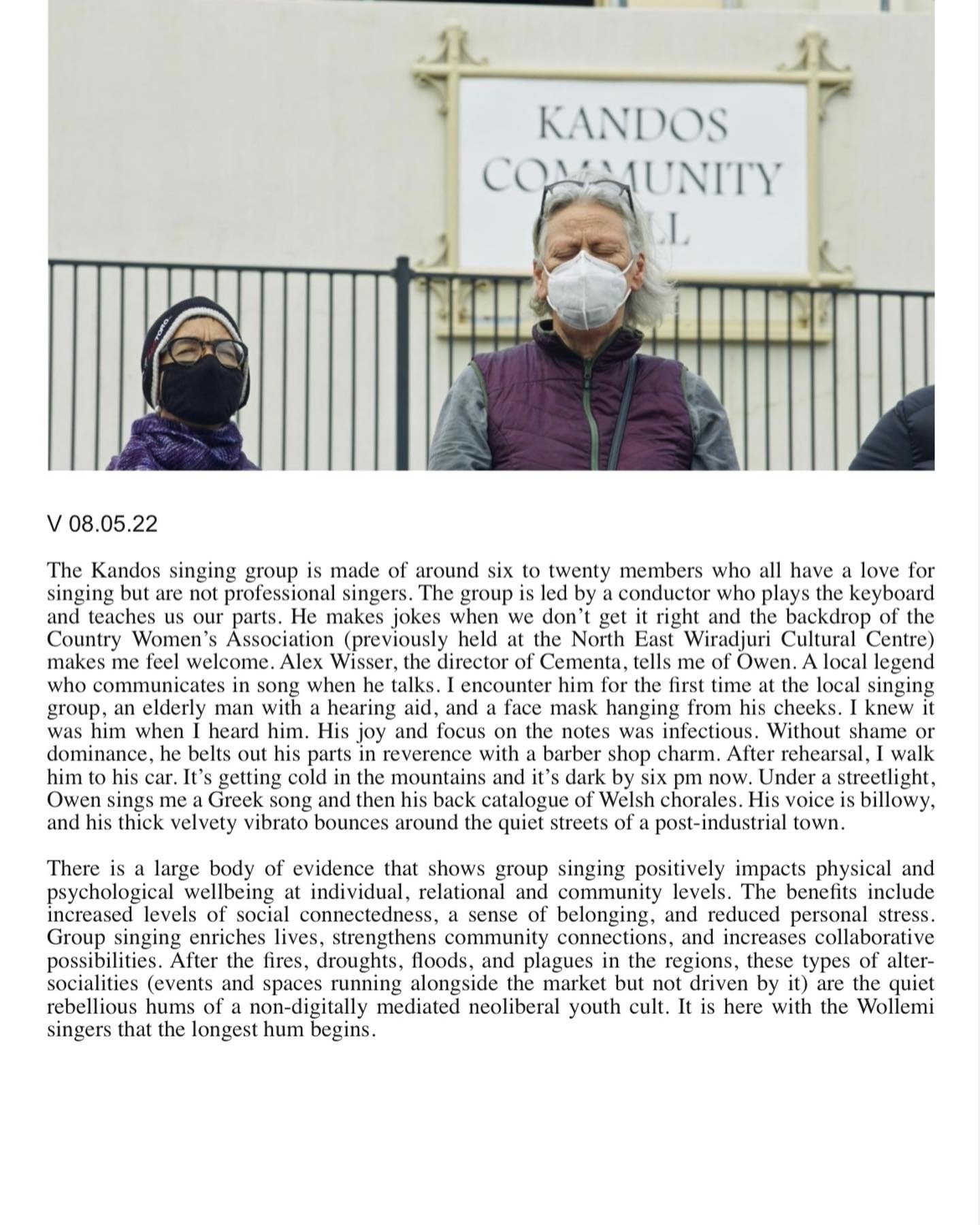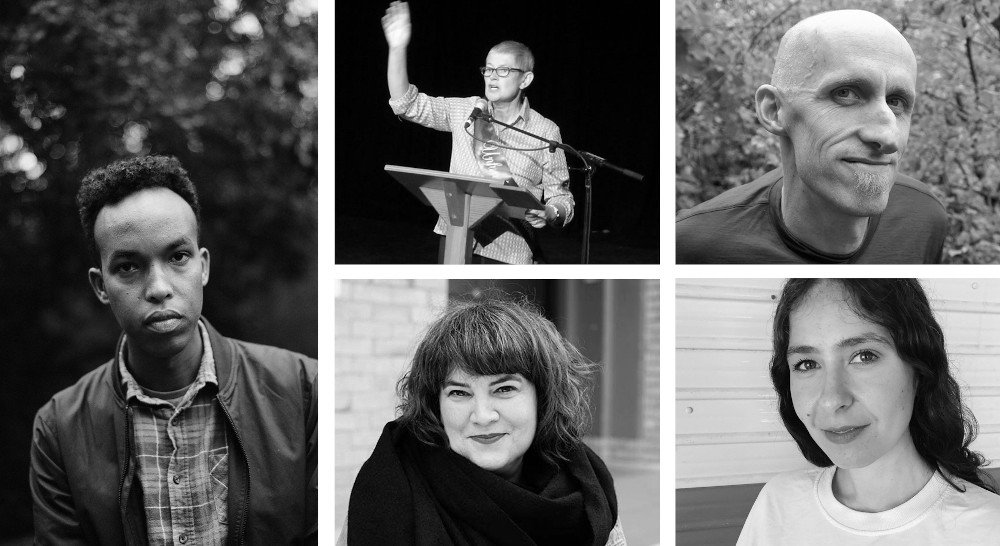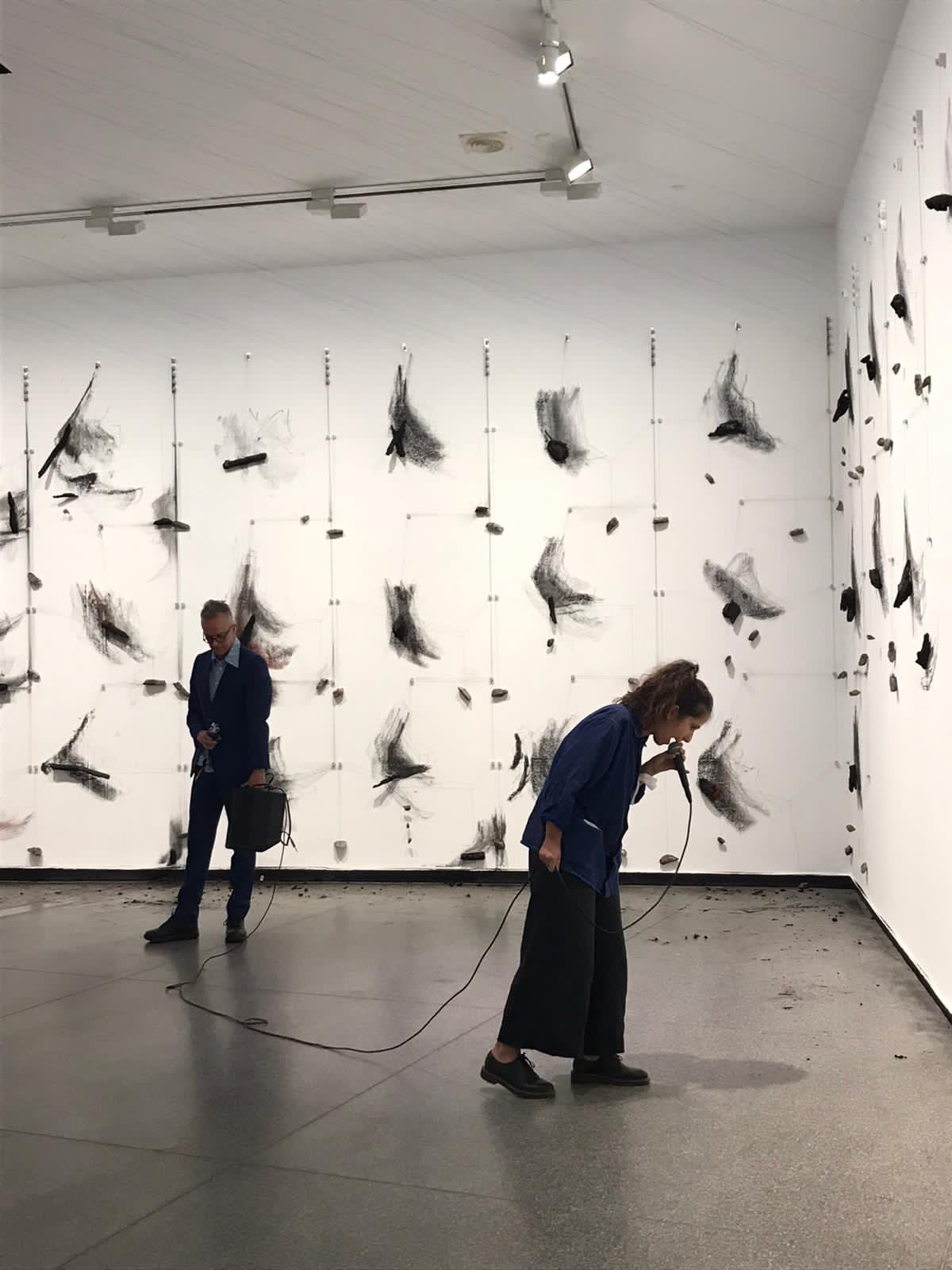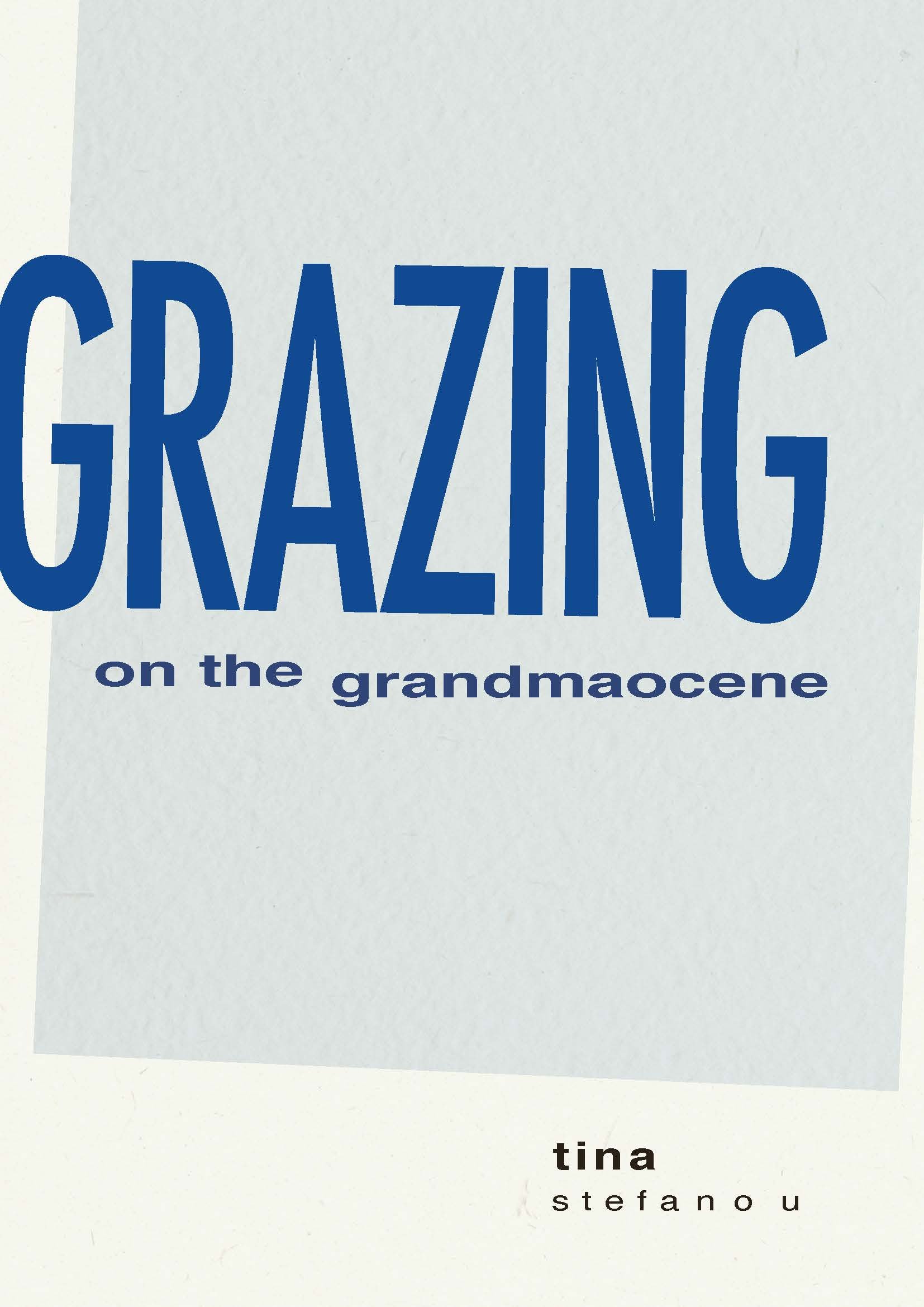Undisciplined Voices (Workshop for Hi-Viz Satellites with Chamber Made and Punctum Inc)
On the 19th of November, I was invited to host a workshop for the 2022 Hi-Viz program with Chamber Made, Punctum Inc and SAtheCollective. This event was taking place simultaneously across two locations in Bendigo and Singapore.
My proposition was: That we undress our practices together, to find a place of integrity and ease in our voices when we speak about what we do, how we do it and what comes next. Moving beyond professionalism or industry speak. How can we talk, act, sing, and move our practices into a planetary dimension? Which is always a collective project. How can the voice support that?
Documentation by photographer Diana Domonkos.
Hym(e)nals
Essay by Tara Heffernan
Hym(e)nals
Multi-Channel Immersive Equine Film and Sound Work ‘Hym(e)nals’ Debuts Melbourne Cup Week.
An imaginative counterpoint to the competitive sport 3rd-5th November at Mission to Seafarers.
Hym(e)nals is a new multi-channel immersive film and sound work by Greek-Australian sonic and visual artist Tina Stefanou, featuring six teenage female horse riders and their elderly equine companions. Premiering on the week of the Melbourne Cup from Thursday 3rd November till Saturday 5th November, the work will be projected on the Norla Dome ceiling at Mission To Seafarers, accompanied with live musical performances each night. Hym(e)nals both mimics and challenges themes in religious paintings, speaking to local ecologies and communities as well as current global events of female solidarity and equality, collective strength, and interspecies communication.
tickets at: https://events.humanitix.com/hym-e-nals
Field noting with Lou Cole and Tina Stefanou. August-Sept, 2022
Rural Utopias Residency: Tina Stefanou in Carnamah #1
Tina Stefanou is currently working with the community of Carnamah. This residency forms part of one of Spaced’s current programs, Rural Utopias.
Here, Tina shares an update from Carnamah.
Field noting with Lou Cole and Tina Stefanou. August-Sept, 2022:
Driving on red gravel roads in the Wild Flower West, Lou an emerging community-arts producer and Tina an emerging artist connect over living in fibro homes, family stories of factory work, and the murky waters of large-scale farming. They are also soaking up the temporary power of wildflowers, only grown in this region; these rare minor blooms provide relief from agribusiness landscapes. The following is a loose bundle of reflections and stories.
*the car radio is quietly playing commentary from New Zealand
Lou: Look look! Over there! A small splash of colour amongst the small native bush. It’s a Donkey Orchid! It’s only taken me ten years to finally see a wildflower!
Arriving in the North Midlands, the majority of my work has been seasonal, and heavily linked to farming (shearing sheds in particular) and agriculture.
Rise before the sun
Prepare a decent lunch, and carry water
Long days of fresh air and seductive rays
The never-ending waving of arms
“Shoofly!”
Return at dark again
I always make sure I know how far I am from the nearest shop just in case I get a chance to pick up and refresh the stocks.
As long as I keep a decent supply of:
Noodles
Canned tuna
Tea bags
Long-life milk
When you are so far away from so-called “civilization” most other things are a luxury.
When I first encountered the wildflowers, I thought I was looking at snow. White Everlastings carpeted the ground for kilometres and kilometres. There for a moment, gone again, just as the snow evaporates.
Today, we may have taken a couple of wrong turns, but we finally found the infamous Wreath Flower. Fully formed and blooming. A small triumph.
*Tina starts clapping
Tina: How do I approach the truck divers? A local shared with me that even the small arts community space in town can feel exclusive.
*A voice appears on the two-way radio, its channel 40. “Sue, can you tell Martin to close the gate.”
Tina: Canola! Liquid gold. My eyes hurt.
Lou: The rolling burn of yellow. Money sure does grow in paddocks around here.
You should look at the statistics on how many millionaires live in this area.
How poor is poor? How rich is rich?
*Lou begins to reflect on her question as she checks the rearview mirror
Are you going without the things you normally have?
Like your phone? Food? Electricity? Internet?
Is your struggle one where you’ve got car problems?
Or not having a car? More likely, not having a license?
Is poverty affecting the way you think about money?
Have you had to make life changes to adapt to poverty?
Maybe you don’t have money, to begin with?
Each one of us takes away a different Taonga (treasure) from what we experience.
I think it is important that we take time to understand other people’s situations, and the enormity of their problems, we need to see it from their shoes or hands or eyes or ears or hooves.
*Tina nods three times
Hardships were never ending in my family, no housing, no car, no electricity, and little to no food. These were regularly occurring events growing up.
Coming to Australia is a huge cycle breaker for those of us that make the sacrifice of leaving behind all we know, and the things we love the most.
Struggling was the way we survived. It’s not easy when the average, yearly household income in your suburb is $18,000. When statistics are stacked against you, the narrative that applies to you is you’ll always be stuck in this cycle of crime, poverty, and abuse.
You put more effort into striving for excellence, always finding a solution, and you step into a state of fearlessness. You realise you have nothing to lose. The only way is forward or….
.
The Longest Hum/ADSR
The Longest Hum interview with Ira Ferris at Sympoiesis Radio →
Babushkarism: Grandmother's Started the Revolution →
Talk on the Art Smitten Podcast and SYN fm radio program with Christina Ulloa Sobarzo about the 67th Blake Prize.
Nina Sanadze's Living Room Project
Planetary Commons: a polysensorial essay—Part One →
On the Holding of Spaces for Essaying Into By Melody Ellis, Andy Jackson, Tina Stefanou, Peta Murray and Khalid Warsame |
This essay was made, variously, on unceded Boon Wurrung, Waddawurrung, Dja Dja Wurrung, and Wurundjeri Country. We extend our respects to the ancestors and Elders of these lands as well as to the custodians of the land and waters across Australia more broadly.
A version of this piece was performed as part of the non/fictionLab Public Forum Series on Thursday, 26 August 2021. Together, we, the writers and makers of this text, bring practices in and across poetry, essay writing, theatre, sonic and visual arts towards the essayesque.
Unheard Relations: Thembi Soddell, Tina Stefanou, Xen Nhà, A Hanley and Joel Stern
The following dialogue — between artists Thembi Soddell, Tina Stefanou, Xen Nhà, and A Hanley, and curator Joel Stern — took place across WhatsApp, Zoom, and Google Docs in November 2020. The purpose was to explore and develop common threads in each artist’s practice, which might inform the preparation for the as-of-the-time-unrealised contributions to Liquid Architecture’s program at McClelland Sculpture Park and Gallery as part of the exhibition Site & Sound. As such, this text has a provisional, speculative quality, serving as an introduction of the artists to one another, and the reader, as well as an articulation of possible directions for the work to come. By the time this text is published and circulated, the commissioned audio pieces will have also been realised. In that sense, we are writing for future readers, including ourselves, with a more complete understanding of what we mean to say.
The song ‘I Want To Know What Love Is’ is playing on the radio in the back of the room — it begins to distort.
(Tina Stefanou)
There is an opportunity to explore the implications of the ‘heard’, the relationship of sound to the listener, and the sonic agencies that point to ‘something’ beyond human perception. For me, ‘the self’ is a multiplicity (the phrase ‘ecologies of selves’ tickles her right ear), there is social and artistic value in giving voice to these multiple states.
(Thembi Soddell)
I often think about how people’s personalities are known to just be a mix of the five or six people we spend the most time with.
A round of applause echoes from the local stadium.
(Tina Stefanou)
(laughs) This makes me think how my chooks and doggy are the five ‘persons’ I have spent the most time with these past months and what that means for my human relations. Moving beyond human exceptionalism, there is a subjectivity of relational interdependence with other-than-humans. I think in terms of more-than-human subjectivity, where the isolating weight of humanism is transformed, ‘feeling into’ those interdependencies — the polyphonic self is always more-than-one, always a process-on-its way, always being-with-others — regardless of what you make.
Tina begins moving her head, mimicking one of her chooks and growling in a canine-like fashion — Thembi joins her.
Excerpt: 002# Manifesting Voice: 34+ Mn(p)ne(u)monic Actions
002# Manifesting Voice: 34+ Mn(p)ne(u)monic Actions, 2021, video documentation of live action, artist-as-avatar, 14 mins.
‘Mimesis got your tongue’
002# Manifesting Voice: 34+ Mn(p)ne(u)monic Actions is a more-than ensounding event. It is both personal and public and acts as a
political engine and loving disruption. Dissolving words into geo and biophonic murmurings, shifts language from a human culturally
encoded position into a Mn(p)ne(u)monic voice. Mn(p)ne(u)monic becoming memory and breath in relational motion.
Singing-with mother tongues across biological and the more-than brings grief into skillfulness. Poethical gestures and vocal associations reflect what it means to live in a time of limited elderhood and planetary commons.
‘Voice-as-urgency’
This work was presented at the 2021 COVA Memory Conference, University of Melbourne.
Featuring: Artist-as-Avatar Sophie Stefanou
*hummmmm ahhh ohhhhhhhhh slipt tone
voice is not individual
voice includes the whole body and everybody
nerves, tissues, bones and spaces
voice is not specialised
voice is not soprano, instrument, orator or lecturer
*ahhhhhh eiiiiiii
voice is flexible
voice is volcanoes
voice is affected by the market
but is not the market
voice is neither the knower or the known
voice is not god
voice is not total
voice is not self-sufficient
voice is not an ideal
voice is not evaluation
voice is not contained yet it contains socio-economic, biological and cultural realties
voice is not object, form or content
voice is not type A
voice is not administrated
voice is not cleverness
is not edited
*aaaaaaahhhhhheiiiiiiiiiyyyyyyooooopig noises
voice is polyphonic subject making
voice is not one
voice is repetition
voice as activities
voice is crafted out of ecologies of practices and never primarily human
voice contains the all-too-human
voice as life-living
voice as the voice-less
voice as shifting law
voice determines its own reason…
*kkakakakakakakkakaahhhhhhhhhhhh
The Singing Alphabet Ensounding—with Robert Andrew’s Tracing Inscriptions, 2020
One steps into a space already laced in language, whether drawn, heard, hung, accidental or empty. David passes me the mic—I refuse to read words. So I sing the alphabet, impulsive vocal pulsations that are absorbed by the walls, bodies and attitudes around me.
Improvisation-is-the-stuff-of-life.
Letters form worlds, echoing and tracing paths from larynx to charcoal. A is not A. It is my breath, 34 years of memories, and the 180-dollar microphone it is bouncing through. Abstracting the alphAphonic choir I reach B. Be careful in front of the art crowd. The singing alphabet is creating space to notice the underlying groundswell of Robert Andrew’s work. Through the ever shifting field of receptivity another life form sings to us as I belt through B—leaning in-between letters the audience begins to notice the subtle ruffling of Carbon. C. The residue of volatile relationships slowly transcribes registers of language on white walls. Timescales collide between human comprehension of wood and fire to the formation of the language of the planet. But where is the smoke in here? Could it be the loud but invisible haze of the double bind?
C emerges like an apparition and through its resonance in my mouth celebrates the cathedral-esque acoustics of the building. C moves freely between the cheeks and transforms into a polymorphic scape. C isn’t caught in between other more rounded letters. C helps us listen and curse. Like carbon, it exists because of exchanges, bonding, breaking up and transferring. Carbon Culture is dirty. D. This letter hits behind the teeth. Teeth formed over millennia, like preserved ore from ships. D feels quick and sharp. The sound is of a string pulling towards E. E. Nasal: it’s easy to project the voice and head deeper into the throat. I am swimming in the eassssiness of E. But nothing is easy here. We’ve gotten used to standing so uncomfortably with each other. H. Hidden postures, fragile smiles, guilty comforts, crick necks, confused kindness and urban slogans. I notice people listening to the distance between one letter and the other. They are noticing the small and potent movements of an alphabet that doesn’t speak English, or a singular Art (cult)ure.
The alphabet that my body is absorbing and producing creates surprising sonic marks, whispers of an ancient song from a Proto-Sinaitic script crafted in Ancient Egypt. These vowels and cadences were formed to represent the language of Semitic-speaking workers and slaves in Egypt, moving away from the exclusionary hieroglyphs of the Pharaohs. What do these sounds do in relation to Andrew’s language and its hidden yet clear-to-see gestures?
Language is not about proficiency, grammar, spelling or robust vernacular. It’s a series of times, proximities and movements filled with the intention of the one who sings it. Of the ones who share it. Of the ones who receive it. Language does not signify semantics – the singing alphabet is not writing over what is already there. These sounds are interplanetary, forged from the sounds of the first utterances of thunder, fire, earthquakes, lava, birthing and stars, indifferent yet contained within the fabric of all words. The word didn’t make flesh. The unstable hot-tempered breath of atmospheres made words. And these words make and unmake worlds.
And what of the places of ums, hums, the awkward silence, the cussing, the climactic grunts, the disappointed sighs, the tired ahhs, the indifferent huh? These are the places where our social alphabet comes into contact with the chimps, the whales, the wind and so on. These in-between jerk reactions create tumbling hybrids and possibilities beyond the logical isolation of words. They are the mineral fragments disguised in tweets, lullabies, sermons and essays.
F. F hardly has a tone, it is all fluffy muscle closed tight between the lips. The F$#@ of things is clear. The mistakes and the frivolity of it all…. I am lost for words… the sensorial serenades I’m using now. To seduce you. Yet the singing alphabet, the carbon choir, is not words and not the seductive sirens of myth. My Greekness is also sewn into this convergence of the English language and the violent origins of multi-time coloniality—the spreading of one sonic world and the many deaths of an(other).
One does not need to understand these utterances in order to feel the intent, to understand the ‘something’ of it. As I squeak, squirt, groan, shiver and twirl my tongue around the room, description and presentation fade into the distance and something more present reveals itself. It’s the ‘something’ that the work won’t lay out in words.
W. Double you. When I watch other people produce sound out loud in public space I see red hot flowers form around their neck and lower cheeks. Like a boa around their vertebra, the social conventions and the amplifying of their voice gives rise to blood lilies. Once they have finished sounding it takes a long time for the red-lights of self-consciousness to fade.
V. Whose Voice is speaking me?
Skipping letters, and gently transposing the civility of order. The singing alphabet begins to sing:information-made-tactile. A spectator approaches me after the performance and said “G. I didn’t even notice that you were singing the alphabet. It wasn’t until you got to M that I thought I just heard L. And it all came together! ”
*hum
Ensounding—with Andrew’s work I sit in the uncomfortable knowing of not knowing but really knowing that there are things about this country I will never understand, hindered by the stringy puppetry of certain wor(l)ds. To really sing through difference together is not contained within words, within the understandable-for-some in the formats of the few, it’s beyond words and beyond description, it’s beyond English even though I am using it as a tool now. It’s through utterances, marks, a willingness to stay with chance and it’s the stark realization of the complex language-as-relation that has come before me that enables me to simply make a sound. Zzzzzz
C HI MP S F O R C HI MP S: A response to a recent performance
A family of nineteen Pan troglodytes are huddled in various configurations. Multi-male, multi-female, cross-generational bodies fill the display. There is action. I witness both horror and affection from these relatives – a mix of social tensions and agreements. Pairs of chimps raise their arms and lock hands in a ceremony of cleaning one another: duets of tender and delicate intimacy. I become a voyeur. I watch a baby chimp move across the family network in cheeky reverie, as its elders effortlessly manage the youngster’s tactility. It climbs all over the group, touching everything with boundless play. Its curious energy expands to the homosapien gaze.
The older chimps turn their backs to us; a turning away from spectacle where an endless herd of weekenders swipe monkey faces across their mucky screens. On the side of my DNA pool, youngsters crouch on the floor mirroring their furrier cousins – they tap on the hard slime between one genetic soup and another. Here the transparent divide dissolves into an uncanny reflection where the aggressive demands of our young human hominids confuse the anthropocentric gaze. I hear grandmother Haraways words: “There is no Eden under glass”; a refraction takes place and a cultural perversion reveals its head.
The 1953 French film essay Les statues meurent aussi (Statues Also Die) explores the French colonial effects on the way African art is perceived by the West. It states, “when human beings die, they enter history. When statues die, they enter art. This botanic death is what we call culture.” These Pan troglodytes are neither the remembered dead or the stolen objects of African antiquity, and yet here they are in a place resembling a museum or a Pierre Huyghe installation where 1000 living trees are placed inside the Sydney Opera House. This is what the film calls “the place where we send objects to die.” In this case, this place is where we conserve the fragments of a fragile animal kingdom – sponsored by Hungry Jacks. A Zoo. The idea of a conserved animal is paralleled to the film’s “dead object” something taken from its original habitat or original significance and becomes reduced to a museum object or exhibit. A living obituary.
Thinking Geographies: A walk with Tina Stefanou
Grandma and Buster, 2019, digital photograph, Jocklebeary Farm.
As we emerge in and out of different levels of crisis, including the ones we were already in before the virus, I am questioning the attitudes, habits, practices, assumptions and taken-for-granted realities of the everyday.
I’ve become more and more suspicious of most things, including my own aspirations – the virus has only sped up these suspicions. I am not referring to conspiracy theories, but rather, questions around forms of production, the politics of living and dying, class disparities, relationships to Earthly living systems and the drive to live through vertical ascent. Individualism has become the altar where personal accumulations of capital are central. Resources are used at any cost for certain individuals to prosper.
Of course this is not everyone: I am referring to the affluent classes. There have been many populations and communities in the past and present that are in forced isolation and crisis, where resources and freedoms are limited and controlled. Not to mention the ongoing crisis for Indigenous communities locally and abroad.
The individual extends and is embedded within complex webs of human exceptionalism, and the military-industrial-political-capital entanglement. As a lucky one – who is part of the educated class but situated within immigrant working class stories – I have recently been upgraded from unemployed student to dole bludger/JobSeeker: what should really be called ‘Life Keeper’. Now that the elite, upper and middle classes are affected by global disparities and bio-political implications, some of the vulnerable and unemployed are considered worthy of living right on the poverty line, instead of below it… but for how long will this act of social service last and what happens to those who are not receiving these benefits?
Excerpts from GRAZING ON THE GRANDMAOCENE
Get off your high horse
A child of the Greek civil war, my grandmother came to Australia as an economic refugee in 1954. She began her Australian life in the rural immigration camps on the border of Victoria and New South Wales. Throughout her life, she encountered multitudes of sonic ecologies, such as the changing environment from Greece to Australia. The air, forests, water, plains, birds, and insects which constructed the geography and climate of her life were fragmented. John Berger calls emigration a type of dismantling of the center of the world, a movement “into a lost, disorientation of fragments.” (1) I contend, that in listening closely to my grandmother's voice I will hear these fragments and traces of her ecological stories.
Grandmother’s voice is paradoxically metaphorical and literal; it is immediate and at the same time it is a cultural constitution. My grandmother has a relationship to the environment and sound, and also a direct relationship with me through the character of her voice. Her voice leaves an imprint on me and informs my microcosm of making and composing. This effect is similar to the way the ecological soundscape imprints and impacts the experience of the listener. Through a system of archetypal sounds like bird song, cicada rhythms, and the ocean—the sense of self and soundscape become inextricably linked. (2)
Andrew Whitehouse unpacks this psychological effect of sound and selfhood when speaking of sonic disappearance. He references the account of a farmer’s experience when encountering the absence of bird song after a spraying program was implemented to control fire ants in his town. The local residents experienced a shock that was “unexpected and unnerving.”(3) Their lives were accompanied by these familiar companions and highlights the emotional effect of changing sonic ecologies on the listener. Whitehouse argues that there are “symbolic and moral connotations of listening to birds in the Anthropocene that follow from their iconic and indexical grounding in places.” (4) This produces a series of anxious semiotics, where even positive affiliations can have “uncertain implications.” (5) I feel these implications when listening to my grandmother’s voice as I witness her eventual disappearance.
1 John Berger, And Our Faces, My Heart, Brief as Photos, (New York: Pantheon Books, 1984), 57.
2 Lawrence Kramer, The Hum of the World: A Philosophy of Listening, (Oakland: University of California Press, 2018), 91.
3 Andrew Whitehouse, “Listening to Birds in the Anthropocene, The Anxious Semiotics of Sound in a Human-Dominated World,” Environmental Humanities, vol. 6, (2015), 55. http://www.environmentalhumanities.org/arch/vol6/6.3.pdf.
4 Whitehouse, “Listening to Birds in the Anthropocene,” 56.
5 ibid






